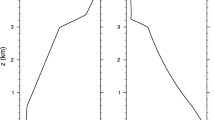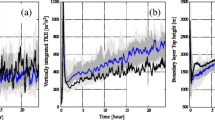Abstract
Cloud droplet dispersion is an important parameter in estimating aerosol indirect effect on climate in general circulation models (GCMs). This study investigates droplet dispersion in shallow cumulus clouds under different aerosol conditions using three-dimensional large eddy simulations (LES). It is found that cloud droplet mean radius, standard deviation, and relative dispersion generally decrease as aerosol mixing ratio increases from 25 mg−1 (clean case) to 100 mg−1 (moderate case), and to 2000 mg−1 (polluted case). Under all the three simulated aerosol conditions, cloud droplet mean radius and standard deviation increase with height. However, droplet relative dispersion increases with height only in the polluted case, and does not vary with height in the clean and moderate cases.
The mechanisms for cloud droplet dispersion are also investigated. An additional simulation without considering droplet collision-coalescence and sedimentation under the aerosol mixing ratio of 25 mg−1 shows smaller values of droplet mean radius, standard deviation, and relative dispersion as compared to the base clean case. This indicates that droplet collision-coalescence plays an important role in broadening droplet spectra. Results also suggest that the impact of homogeneous mixing on cumulus cloud droplet spectra is significant under all the three simulated aerosol conditions. In weak mixing (strong updraft) regions where clouds are closer to be adiabatic, cloud droplets tend to have larger mean radius, smaller standard deviation, and hence smaller relative dispersion than those in stronger mixing (downdraft or weak updraft) regions.
The parameterized cloud optical depth in terms of cloud liquid water content, droplet number concentration, and relative dispersion is only slightly smaller than the result calculated from detailed droplet spectra, indicating that current parameterization of cloud optical depth as used in many GCMs is plausible for low clouds.
Similar content being viewed by others
References
Albrecht, B. A., 1989: Aerosols, cloud microphysics, and fractional cloudiness. Science, 245(4923), 1227–1230.
Arabas, S., H. Pawlowska, and W. W. Grabowski, 2009: Effective radius and droplet spectral width from in-situ aircraft observations in trade-wind cumuli during RICO. Geophys. Res. Lett., 36, doi: 10.1029/2009gl038257.
Deng, Z. Z., C. S. Zhao, Q. Zhang, M. Y. Huang, and X. C. Ma, 2009: Statistical analysis of microphysical properties and the parameterization of effective radius of warm clouds in Beijing area. Atmos. Res., 93(4), 888–896.
Intergovernmental Panel on Climate Change, 2007: Climate Change 2007: The Physical Science Basis. Contribution of Working Group I to the Fourth Assessment Report of the Intergovernmental Panel on Climate Change. New York, Cambridge Unversity Press, 136 pp.
Liu, Y. G., and P. H. Daum, 2000: Spectral dispersion of cloud droplet size distributions and the parameterization of cloud droplet effective radius. Geophys. Res. Lett., 27(13), 1903–1906.
—, and —, 2002: Anthropogenic aerosols-indirect warming effect from dispersion forcing. Nature, 419(6907), 580–581.
—, —, and S. S. Yum, 2006: Analytical expression for the relative dispersion of the cloud droplet size distribution. Geophys. Res. Lett., 33(2), doi: 10.1029/2005gl024052.
Liu, Y. G., P. H. Daum, H. Guo, and Y. R. Peng, 2008: Dispersion bias, dispersion effect, and the aerosolcloud conundrum. Environ. Res. Lett., 3(4), doi: 10.1088/1748-9326/3/4/045021.
Lu, M. L., and J. H. Seinfeld, 2006: Effect of aerosol number concentration on cloud droplet dispersion: A large-eddy simulation study and implications for aerosol indirect forcing. J. Geophys. Res. -Atmos., 111(D2), doi: 10.1029/2005jd006419.
—, W. C. Conant, H. H. Jonsson, V. Varutbangkul, R. C. Flagan, and J. H. Seinfeld, 2007: The Marine Stratus/Stratocumulus Experiment (MASE): Aerosol-cloud relationships in marine stratocumulus. J. Geophys. Res. -Atmos., 112(D10), doi: 10.1029/2006jd007985.
—, G. Feingold, H. H. Jonsson, P. Y. Chuang, H. Gates, R. C. Flagan, and J. H. Seinfeld, 2008: Aerosolcloud relationships in continental shallow cumulus. J. Geophys. Res. -Atmos., 113(D15), doi: 10.1029/2007jd009354.
Martins, J. A., and M. A. F. S. Dias, 2009: The impact of smoke from forest fires on the spectral dispersion of cloud droplet size distributions in the Amazonian region. Environ. Res. Lett., 4(1), doi: 10.1088/1748-9326/4/1/015002.
Miles, N. L., J. Verlinde, and E. E. Clothiaux, 2000: Cloud droplet size distributions in low-level stratiform clouds. J. Atmos. Sci., 57(2), 295–311.
Pawlowska, H., W. W. Grabowski, and J. L. Brenguier, 2006: Observations of the width of cloud droplet spectra in stratocumulus. Geophys. Res. Lett., 33(19), doi: 10.1029/2006gl026841.
Peng, Y. R., and U. Lohmann, 2003: Sensitivity study of the spectral dispersion of the cloud droplet size distribution on the indirect aerosol effect. Geophys. Res. Lett., 30(10), doi: 10.1029/2003gl017192.
—, U. Lohmann, R. Leaitch, and M. Kulmala, 2007: An investigation into the aerosol dispersion effect through the activation process in marine stratus clouds. J. Geophys. Res. -Atmos., 112(D11), doi: 10.1029/2006jd007401.
Rotstayn, L. D., and Y. G. Liu, 2003: Sensitivity of the first indirect aerosol effect to an increase of cloud droplet spectral dispersion with droplet number concentration, J. Climate. 16(21), 3476–3481.
Shaw, R. A., W. C. Reade, L. R. Collins, J. Verlinde, 1998: Preferential concentration of cloud droplets by turbulence: Effects on the early evolution of cumulus cloud droplet spectra. J. Atmos. Sci., 55(11), 1965–1976.
Siebesma, A. P., et al., 2003: A large eddy simulation intercomparison study of shallow cumulus convection. J. Atmos. Sci., 60(10), 1201–1219.
Twomey, S., 1974: Pollution and planetary albedo. Atmos. Environ., 8(12), 1251–1256.
—, 1977: Influence of pollution on shortwave albedo of clouds. J. Atmos. Sci., 34(7), 1149–1152.
Wang, J., P. H. Daum, S. S. Yum, Y. A. Liu, G. I. Senum, M. L. Lu, J. H. Seinfeld, and H. Jonsson, 2009: Observations of marine stratocumulus microphysics and implications for processes controlling droplet spectra: Results from the Marine Stratus/Stratocumulus Experiment. J. Geophys. Res. -Atmos., 114, doi: 10.1029/2008jd011035.
Warner, J., 1969: Microstructure of cumulus cloud. Part I: General features of droplet spectrum. J. Atmos. Sci., 26(5), 1049–1059.
Xue, H. W., and G. Feingold, 2004: A modeling study of the effect of nitric acid on cloud properties. J. Geophys. Res. -Atmos., 109(D18), doi: 10.1029/2004jd004750.
—, and —, 2006: Large-eddy simulations of trade wind cumuli: Investigation of aerosol indirect effects. J. Atmos. Sci., 63(6), 1605–1622.
Yum, S. S., and J. G. Hudson, 2005: Adiabatic predictions and observations of cloud droplet spectral broadness. Atmos. Res., 73(3–4), 203–223.
Zhao, C. S., et al., 2006: Aircraft measurements of cloud droplet spectral dispersion and implications for indirect aerosol radiative forcing. Geophys. Res. Lett., 33(16), doi: 10.1029/2006gl026653.
Author information
Authors and Affiliations
Corresponding author
Additional information
Supported by the 11th Five-Year National Key Technology R&D Program of China under Grant No. 2006BAC12B003 and National Natural Science Foundation of China under Grant No. 40675004.
Rights and permissions
About this article
Cite this article
Wang, X., Xue, H., Fang, W. et al. A study of shallow cumulus cloud droplet dispersion by large eddy simulations. Acta Meteorol Sin 25, 166–175 (2011). https://doi.org/10.1007/s13351-011-0024-9
Received:
Revised:
Published:
Issue Date:
DOI: https://doi.org/10.1007/s13351-011-0024-9




